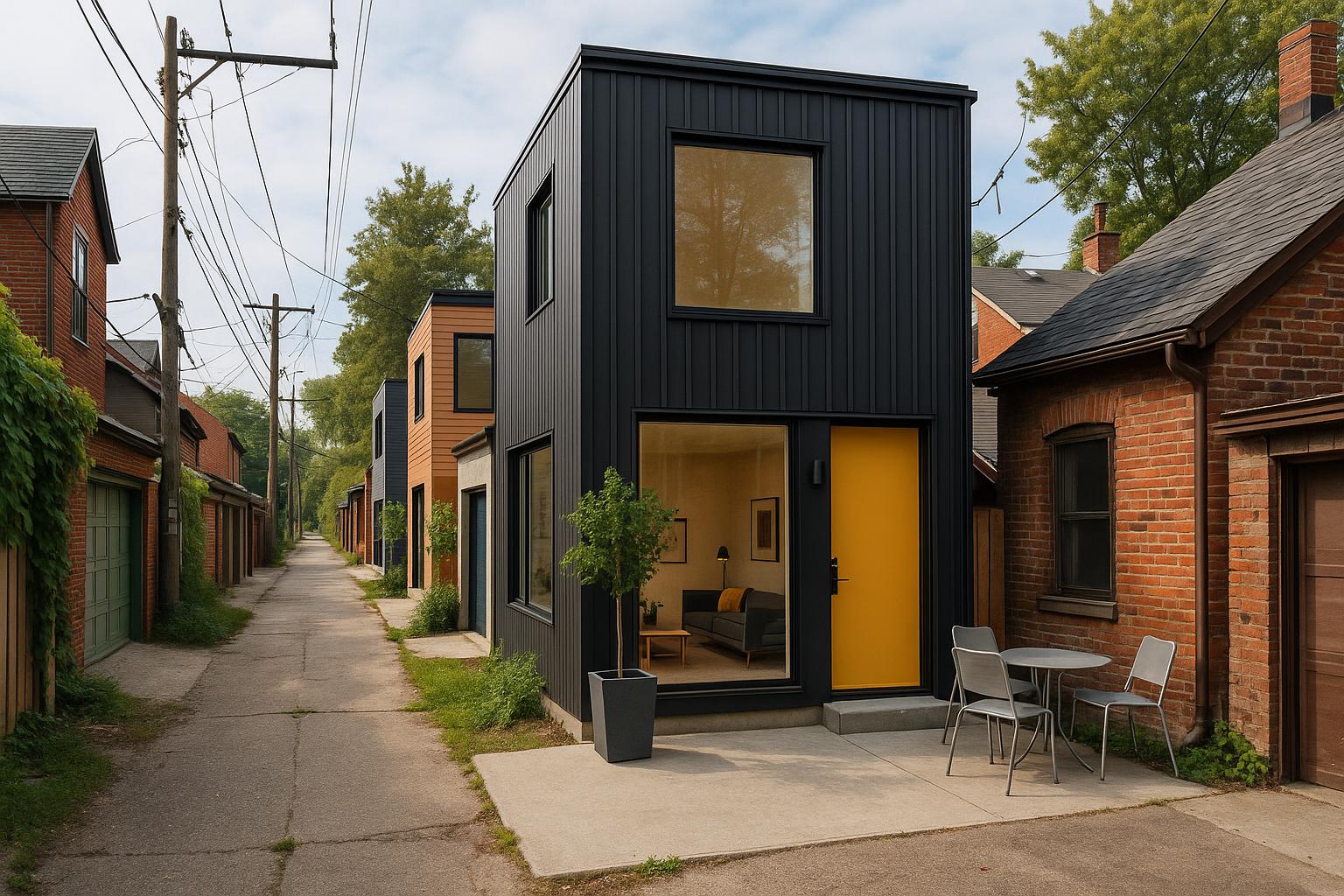
Alleyway Housing Canada: Unlocking Urban Spaces for Innovative Urban Redevelopment
Estimated reading time: 10 minutes
Key Takeaways
- Innovative Urban Redevelopment: Alleyway housing transforms neglected alleyways into vibrant, affordable living spaces.
- Tiny Home Infill: Utilizes compact, energy-efficient designs to maximize the potential of small spaces.
- Sustainability: Promotes greener cities by optimizing existing infrastructure and reducing urban sprawl.
- Community Revitalization: Encourages gentle density while preserving neighbourhood character.
- Regulatory Innovation: Requires thoughtful coordination among city planners, developers, and residents to navigate zoning and design standards.
Table of Contents
- Introduction: Alleyway Housing Canada and Urban Redevelopment
- Understanding Alleyway Housing: Urban Redevelopment Defined
- Advantages of Alleyway Housing in Canadian Cities
- Examples and Case Studies
- Design and Regulatory Considerations
- Future Potential and Call to Action
- Conclusion
- Frequently Asked Questions
Introduction: Alleyway Housing Canada and Urban Redevelopment
Alleyway housing Canada is an innovative approach to urban redevelopment embraced by city planners, architects, and homeowners across the nation. With Canadian cities facing a significant housing shortage driven by rapid population growth, rising costs, and increasing urban density, innovative solutions are essential.
Traditional urban growth has its limits. Scarce land, high construction costs, and the challenges of expanding city boundaries necessitate alternative approaches. Enter alleyway housing Canada—transforming overlooked alleyways into accessible residential spaces using tiny home infill to provide affordable, sustainable, community-focused housing.
For further insights, refer to the detailed analysis by the Canada Mortgage and Housing Corporation.
Understanding Alleyway Housing: Urban Redevelopment Defined
Alleyway housing converts underused lanes into small-scale homes—also known as laneway houses, coach houses, or garden suites. These structures, ranging typically from 400 to 1,200 square feet, offer practical living spaces in areas once designated for vehicles and utilities.
This new approach to urban density fits within broader redevelopment efforts, emphasizing efficient land use and community-friendly growth. Similarly, tiny home infill focuses on constructing compact, energy-efficient homes on small or unusual lots.
To delve deeper, review research from the Urban Institute and our guide to tiny home living.
Advantages of Alleyway Housing in Canadian Cities
Integrating alleyway housing into Canadian cities offers a multitude of benefits. These projects provide:
- Alleviation of Housing Shortages: New homes can be added quickly and discreetly, expanding the housing supply.
- Affordability and Accessibility: Smaller homes are less expensive to build and maintain. They enable home ownership or rental opportunities for a diverse range of residents. Learn more about accessible designs in our guide on tiny homes for seniors.
- Sustainability and Smarter Growth: Utilizing pre-existing infrastructure optimizes space and reduces urban sprawl. This also supports environmental goals by decreasing land use and carbon footprints. For additional insights, see sustainable tiny home living.
- Community Revitalization: Gentle density increases economic opportunities while preserving local heritage and community character.
The city of Vancouver serves as a powerful case study, where laneway housing initiatives have successfully added over 4,000 units since 2009. More details can be found on the City of Vancouver’s website.
Examples and Case Studies: Alleyway Housing, Tiny Home Infill, Urban Redevelopment
Across Canada, several cities have implemented innovative alleyway housing projects:
Vancouver: National Leader in Laneway Homes
- Introduced alleyway housing policies in the late 2000s.
- Over 4,000 laneway homes approved since 2009.
- Streamlined permitting processes that accelerated project adoption.
- Maintained heritage streetscapes while integrating modern living.
More information is available at the Vancouver City website.
Toronto: Garden and Laneway Suites Initiative
- Features secondary suites and garden suites across urban back lanes.
- Encourages gentle density with supportive grants and streamlined regulations.
- Ongoing community engagements to address zoning and local concerns.
Explore more about Toronto’s initiatives at the City of Toronto website and guidance on ADU permitting here.
Calgary and Edmonton: Zoning Reform and Pilot Projects
Both cities have modernized zoning bylaws to facilitate backyard, garage, and laneway suites. Pilot programs are currently assessing integration with utilities and infrastructure requirements.
Detailed case studies on urban infill strategies can be found here.
Design and Regulatory Considerations: Alleyway Housing in Canadian Cities
The success of alleyway housing relies on navigating local zoning, design, and regulatory requirements. Common considerations include:
- Lot Size and Setbacks: Minimum lot dimensions, required setbacks from lot lines, and distance from existing structures.
- Building Height and Floor Area: Restrictions to ensure new structures harmonize with their surroundings.
- Parking and Occupancy: Guidelines that may reduce parking requirements to encourage higher density.
Cities often offer pre-approved designs and fast-track permitting processes to assist homeowners. For a broad overview on collaborative zoning strategies, visit the American Planning Association and our Canadian ADU Regulations Guide.
Future Potential and Call to Action: Alleyway Housing Canada and Alternative Housing Sites
The transformative potential of alleyway housing lies in its ability to create healthier, more sustainable communities:
- Healthier Neighbourhoods: Compact, walkable communities that encourage multigenerational living.
- Sustainable Urban Growth: Increased housing supply without sacrificing green space or community character.
- Diverse Housing Options: Flexible living arrangements that cater to students, families, seniors, and more.
Stakeholders—from homeowners and developers to city planners—are encouraged to explore potential projects. Refer to resources like the benefits of secondary units for further guidance.
Key resources include the Toronto Planning Department, Vancouver Laneway Housing Information, and the Canadian Urban Institute.
Conclusion: Alleyway Housing Canada Means Innovative Urban Redevelopment
Alleyway housing Canada represents a practical, forward-thinking solution to the growing housing crisis. By repurposing underused alleyways, cities can add affordable homes while preserving community charm and supporting sustainable growth.
Embracing complementary strategies like tiny home infill provides a robust toolkit for addressing housing needs. As cities continue to evolve, community engagement, adaptive zoning, and careful planning will be key to transforming urban landscapes.
For more on this topic, visit the Canadian Urban Institute or the Canada Mortgage and Housing Corporation. Dive deeper into urban infill solutions by exploring our discussion at Urban Infill & Tiny Homes.
Frequently Asked Questions
What is alleyway housing Canada?
It is an innovative form of urban redevelopment where neglected alleyways are transformed into residential units, often utilizing compact designs like tiny home infill to maximize limited space.
How does tiny home infill complement alleyway housing?
Tiny home infill focuses on constructing small, energy-efficient homes on unconventional lots, making it an ideal solution to increase housing density without altering neighbourhood character.
Are there regulatory challenges with implementing these projects?
Yes, issues such as zoning restrictions, lot size requirements, and permitting processes can pose challenges. However, many cities are updating their policies to support such innovative housing solutions.
Where can I find more resources about alleyway housing in Canada?
Additional information is available through resources like the Canada Mortgage and Housing Corporation, the Canadian Urban Institute, and various municipal websites.

Leave a Reply